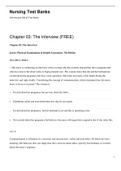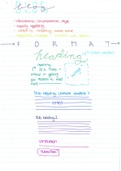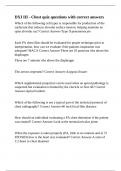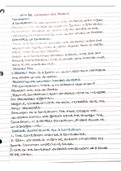BTEC Assignment Brief
Pearson BTEC Level 3 National Foundation Diploma in Applied
Science
Qualification
Pearson BTEC Level 3 National Diploma in Applied Science
Pearson BTEC Level 3 National Extended Diploma in Applied Science
Unit number and title Unit 18: Industrial Chemical Reactions
B: Investigate factors affecting rate of reaction in order to
Learning aim understand collision theory
Assignment title Rate of reaction
Assessor
Issue date
Hand in deadline
You are a level 3 apprentice laboratory technician employed by
Monarch Chemicals, a UK based company manufacturing a variety
of inorganic chemicals.
Vocational Scenario or Every three months you undertake an assessment that allows the
Context company to monitor your progress and provide evidence that you
are meeting the technical competencies you must master to
complete your apprenticeship. In this assignment brief you will
complete an assessment activity to demonstrate your knowledge of
how rates of industrial reactions can be influenced.
Using your lesson notes and research into rates if reactions to
complete the following assessment activities:
1) Rate of reaction investigations
Carry out investigations to explain the effect on rate of reaction of:
concentration (e.g. hydrochloric acid with calcium carbonate,
Task 1 or sodium thiosulfate with hydrochloric acid, or crystal violet
with sodium hydroxide)
particle size (e.g. hydrochloric acid with calcium carbonate or
hydrochloric acid with magnesium ribbon)
temperature (e.g. sodium thiosulfate with hydrochloric acid,
or potassium persulfate with iodide)
catalysts
o homogeneous (e.g. effect of cobalt(II) chloride on the
rate of the reaction between potassium sodium 2,3-
dihydroxybutaneiodate and hydrogen peroxide)
o heterogeneous (e.g. effect of different potential
catalysts on the decomposition of hydrogen peroxide)
For each factor, carry out one of the suggested reactions to
investigate the effect on the rate of reaction. You will need to
research a suitable method to safely measure the amounts of
reactants or products against time for these reactions. You will need
, to check your methods with your assessor before undertaking any
practical work.
For your investigations into concentration, particle size and
temperature, produce accurately plotted graphs to illustrate the
effect of each on the rate of a reaction. Draw conclusions and use
kinetic theory (collision theory, reaction profiles, activation energy
and the Maxwell-Boltzmann distribution) to explain the effect of
each factor.
For each of the concentration / time graphs that you have produced
in your concentration investigation, draw a tangent to each curve at
time zero (i.e. the initial concentration of the reactant). Calculate
the gradient of each of tangents to determine the rate of reaction at
each concentration.
Calculation worksheet A – Rate Equation
Under supervision in class, complete the calculation worksheet A to
demonstrate that you are able to accurately determine of
reaction order, overall rate equation, rate constant and units for
simple and complex data.
Calculations worksheet B – Activation Energy
Under supervision in class, complete calculation worksheet B to
demonstrate that you are able to accurately determine the
activation energy of a reaction from data on the rate constant at
different temperatures.
Checklist of evidence
Laboratory report of the investigation into the factors effecting
required the rate of reaction, with an observation to support the
authenticity of the practical work
Completed calculations worksheet A – Rate Equation
Completed calculations worksheet B – Activation Energy
Criteria covered by this task:
Unit/Criteria
To achieve the criteria, you must show that you are able to:
reference
Demonstrate accurate determination of reaction order, overall rate equation and
B.D2
rate constant and units for complex data.
Demonstrate accurate determination of reaction order, overall rate equation,
B.M4
rate constant and its units for straightforward data.
Carry out calculations to accurately determine the activation energy of a
B.M5
reaction from data on the rate constant at different temperatures.
Carry out calculations to determine the correct rate of reaction from the
B.P4
concentration/time plots.
Explain the factors affecting rate of reaction.
B.P5
Sources of information https://adamcap.com/schoolwork/the-kinetics-of-the-bromate-
to support you with bromide-reaction/
this Assignment
http://webfronter.com/se/htx/HX1215UVB/other/
12%20Determination%20of%20the%20Order%20of%20a
2
BTEC Assignment Brief v1.0
BTEC Internal Assessment QDAM January 2015
Pearson BTEC Level 3 National Foundation Diploma in Applied
Science
Qualification
Pearson BTEC Level 3 National Diploma in Applied Science
Pearson BTEC Level 3 National Extended Diploma in Applied Science
Unit number and title Unit 18: Industrial Chemical Reactions
B: Investigate factors affecting rate of reaction in order to
Learning aim understand collision theory
Assignment title Rate of reaction
Assessor
Issue date
Hand in deadline
You are a level 3 apprentice laboratory technician employed by
Monarch Chemicals, a UK based company manufacturing a variety
of inorganic chemicals.
Vocational Scenario or Every three months you undertake an assessment that allows the
Context company to monitor your progress and provide evidence that you
are meeting the technical competencies you must master to
complete your apprenticeship. In this assignment brief you will
complete an assessment activity to demonstrate your knowledge of
how rates of industrial reactions can be influenced.
Using your lesson notes and research into rates if reactions to
complete the following assessment activities:
1) Rate of reaction investigations
Carry out investigations to explain the effect on rate of reaction of:
concentration (e.g. hydrochloric acid with calcium carbonate,
Task 1 or sodium thiosulfate with hydrochloric acid, or crystal violet
with sodium hydroxide)
particle size (e.g. hydrochloric acid with calcium carbonate or
hydrochloric acid with magnesium ribbon)
temperature (e.g. sodium thiosulfate with hydrochloric acid,
or potassium persulfate with iodide)
catalysts
o homogeneous (e.g. effect of cobalt(II) chloride on the
rate of the reaction between potassium sodium 2,3-
dihydroxybutaneiodate and hydrogen peroxide)
o heterogeneous (e.g. effect of different potential
catalysts on the decomposition of hydrogen peroxide)
For each factor, carry out one of the suggested reactions to
investigate the effect on the rate of reaction. You will need to
research a suitable method to safely measure the amounts of
reactants or products against time for these reactions. You will need
, to check your methods with your assessor before undertaking any
practical work.
For your investigations into concentration, particle size and
temperature, produce accurately plotted graphs to illustrate the
effect of each on the rate of a reaction. Draw conclusions and use
kinetic theory (collision theory, reaction profiles, activation energy
and the Maxwell-Boltzmann distribution) to explain the effect of
each factor.
For each of the concentration / time graphs that you have produced
in your concentration investigation, draw a tangent to each curve at
time zero (i.e. the initial concentration of the reactant). Calculate
the gradient of each of tangents to determine the rate of reaction at
each concentration.
Calculation worksheet A – Rate Equation
Under supervision in class, complete the calculation worksheet A to
demonstrate that you are able to accurately determine of
reaction order, overall rate equation, rate constant and units for
simple and complex data.
Calculations worksheet B – Activation Energy
Under supervision in class, complete calculation worksheet B to
demonstrate that you are able to accurately determine the
activation energy of a reaction from data on the rate constant at
different temperatures.
Checklist of evidence
Laboratory report of the investigation into the factors effecting
required the rate of reaction, with an observation to support the
authenticity of the practical work
Completed calculations worksheet A – Rate Equation
Completed calculations worksheet B – Activation Energy
Criteria covered by this task:
Unit/Criteria
To achieve the criteria, you must show that you are able to:
reference
Demonstrate accurate determination of reaction order, overall rate equation and
B.D2
rate constant and units for complex data.
Demonstrate accurate determination of reaction order, overall rate equation,
B.M4
rate constant and its units for straightforward data.
Carry out calculations to accurately determine the activation energy of a
B.M5
reaction from data on the rate constant at different temperatures.
Carry out calculations to determine the correct rate of reaction from the
B.P4
concentration/time plots.
Explain the factors affecting rate of reaction.
B.P5
Sources of information https://adamcap.com/schoolwork/the-kinetics-of-the-bromate-
to support you with bromide-reaction/
this Assignment
http://webfronter.com/se/htx/HX1215UVB/other/
12%20Determination%20of%20the%20Order%20of%20a
2
BTEC Assignment Brief v1.0
BTEC Internal Assessment QDAM January 2015










